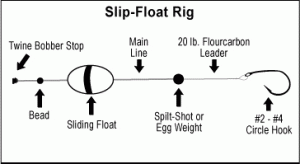Pro Angles Inshore – Capt. Rob Koraly
Speckled trout love the tidal currents. Much like their freshwater cousins, they usually suspend above the bottom, headfirst in the current allowing the flow of water to bring the food to them.
Shrimp, however, do not love tidal currents. They can’t swim and maneuver the same way baitfish can, and as a result, 2-4” shrimp are completely at the mercy of the current flow and the gamefish lying in wait. This is the main reason why shrimp are the top live bait for catching speckled trout.
When fishing live shrimp in a current, you want to imitate that natural occurrence of the shrimp drifting free with the current, suspended 2-3’ off the bottom. The most effective and efficient way to achieve this natural presentation is with a slip-float rig. It’s called a slip-float rig because the float slides freely on the fishing line, as opposed to being affixed in one place.
The advantage of this setup is that you can put that live shrimp at whatever depth you want and adjust it on the fly, all while having a visual strike indicator. The key to the depth adjustment in this rig lies in the float stopper.
A float stopper, or bobber stopper, is a small diameter piece of brightly colored twine wrapped around a small plastic tube. The tube and twine slides onto the main fishing line, the twine slides off the tube towards the rod-tip, and the tube slides off the line and into the trash.
The twine stopper is tightened around the main line by pulling both tag ends. The resulting knot will stop a small plastic bead, which will stop the float or bobber from sliding past the stopper. The stopper itself can be adjusted simply by firmly pinching it and sliding it up or down the line to achieve the desired depth. If you want your bait to drift along 10’ deep, then set the stopper 10’ from the hook.
Split shots or an egg sinker will be required in order to get the shrimp down to the desired depth quickly and keep it there. A good rule is to use just enough weight to keep the shrimp from rising up in the current, and to keep it 10-12” ahead of the hook.
As far as your leader goes, a 20 lb. test, 15-24” fluorocarbon leader is a must for line-shy specks. I prefer to use a circle hook on this rig, especially when trout fishing. Trout are well-known for their soft mouths and their head-shaking, hook-throwing abilities. A circle hook in the corner of the jaw stands a better chance of staying there than a treble hook stuck in the top of that soft mouth, especially with bigger fish.
Whatever hook you choose to use, try to match the size of the hook to the size of the bait. Use #4 circles or #8 trebles with smaller shrimp, and use #2 circles or #6 trebles for bigger bugs. You want to hook your shrimp just under the horn on his head, making sure not to go through the black spots that mark its vitals. This will keep the shrimp lively and allow it to swim freely and naturally.
That’s the rig. Now here’s how to use it. Speckled trout show up in a number of different places, such as marsh creeks in the sound, inlets, residential canals, and river bottlenecks. These are the places where trout use the stronger current flows in relatively deeper (5-20’) water to their advantage, and these are the places you want to be drifting live shrimp.
There are two ways to present your live shrimp on the slip-float rig. You can anchor up-current of where you want to fish and free-line the rig down-current with the bail open, stripping line off with your hand to keep a drag-free drift.
The other option is to drift right along with the rig. Either way, the rig has to drift naturally with the current, but you don’t want excessive slack in the line because you will not be able to recover the slack and set the hook quickly enough when the float goes under.
You should adjust the depth of your shrimp until you find the most successful pattern, but I’ve always had the best luck setting the bait 1-3’ above the bottom. When the float disappears, close the bail and wind into the fish…the circle hook will set itself. If you are not using a circle hook, you will have to set the hook, but don’t put a lip-ripping hook-set on those soft-mouthed specks.
When rigged properly with a frisky live shrimp, the slip-float rig can be the deadliest weapon in your specked trout arsenal. Side-effects may include bent rods, smiling faces, and full coolers. Good fishing and good living.






